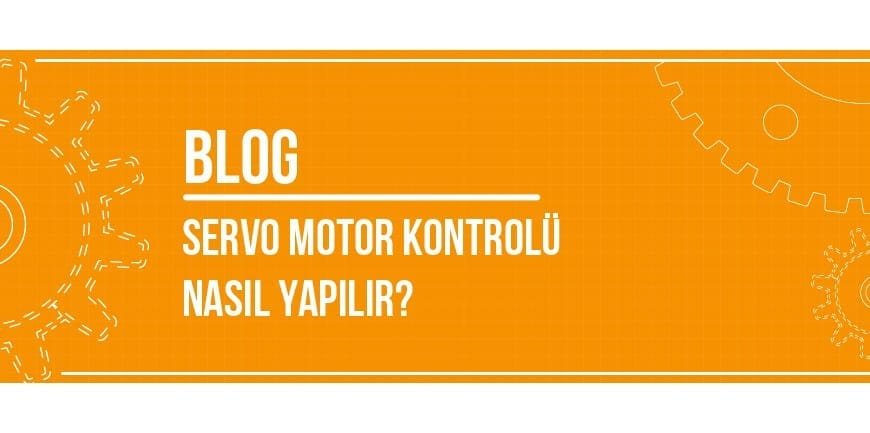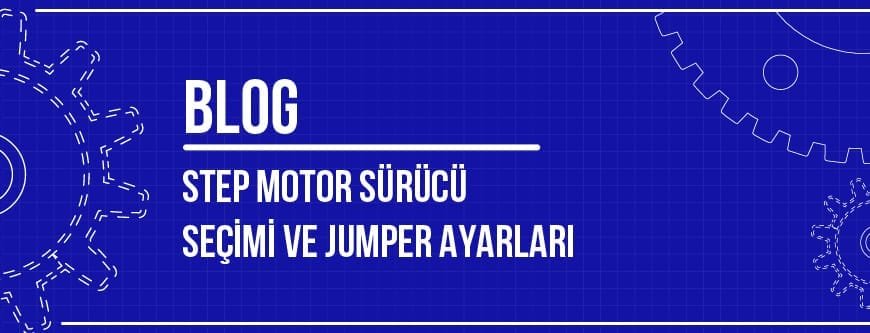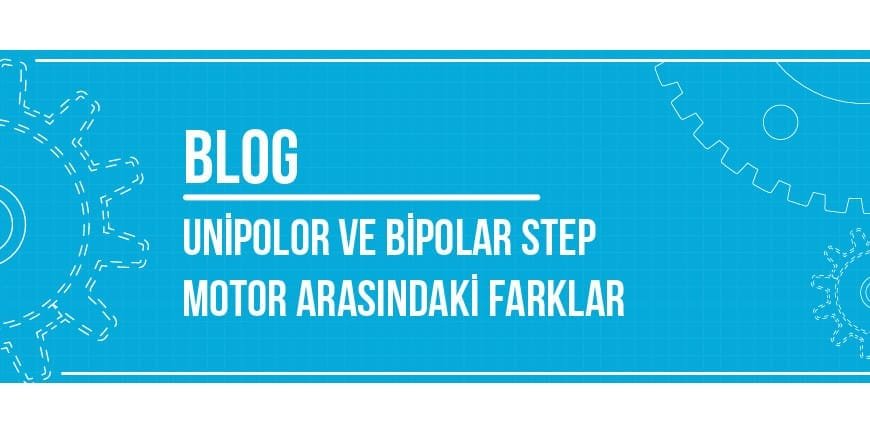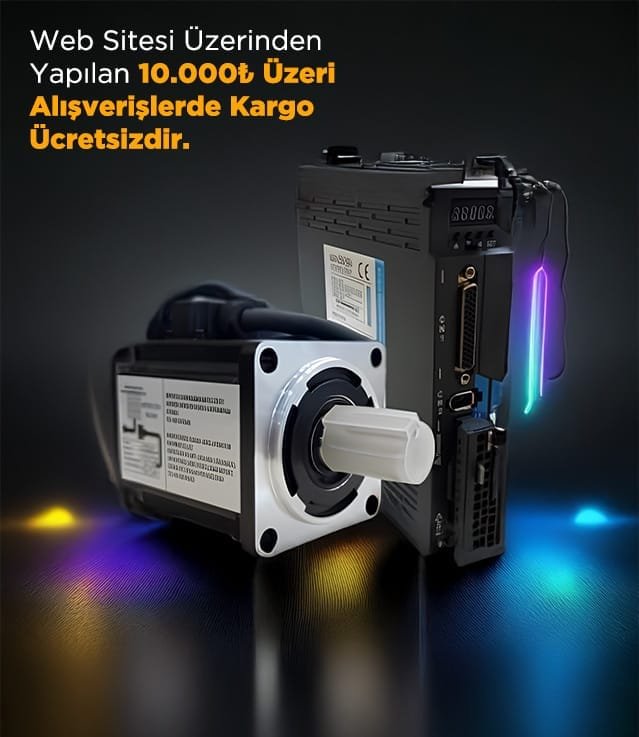
İçindekiler
Frequently Asked Questions About Servo Motor
We receive many questions about servo motors. At Şahin Rulman, we will try to answer your questions such as “What is a servo motor?”, “How does a servo motor work?”, “What is the internal structure of a servo motor?”, and “Where are servo motors used?” in this week’s blog post. We hope this blog post will be useful for those seeking information about servo motors. Happy reading!
What is a Servo Motor?
A servo motor is a motor system that detects and corrects errors in the operation of a mechanism through a feedback control system, ensuring high-level position adjustment, acceleration, and speed control. In other words, it is a system that maximizes motion control to eliminate errors, particularly in operations requiring very precise adjustments in motion and position, thereby increasing operational efficiency.
Servo Motor Types
You must select the appropriate servo motor type based on your operational requirements. When choosing between AC servo motors and DC servo motors, the desired performance level must be considered. AC (brushless) servo motors are primarily used in large-scale projects requiring high power. DC (brushed) servo motors offer easier torque and power control compared to AC servo motors. DC servo motors are preferred for smaller applications. Due to the internal structure of servo motors, there is also a brake servo motor model. Brake servo motors stop the servo motor and protect it in situations where there is a high risk of damage to the servo.
You can find detailed information about the difference between AC and DC servo motors in our related blog post.
How Does a Servo Motor Work?
In this section of our article, we will discuss the working principle of servo motors in detail. Servo motors that can be used with computer-aided systems have an encoder attached to them. The encoder transmits the necessary signals to the servo driver in order to continuously control the direction, angle, and speed of the servo motor. The servo motor driver then activates the servo motor according to the signals it receives. Feedback signals are used to determine the accuracy level of the commands given to the servo motor. This ensures complete control over the operations to be performed, reduces the margin of error, and increases efficiency.
We have provided a general overview of the working principle of servo motors. For those who need more detailed information on the working principle of servo motors, we can provide a more comprehensive explanation:
Servo motors are more sophisticated than other motor types in terms of their operating principle, which is why they also differ in price. Examining the operating principles of servo motors, signals received via PLC or PC connection are transmitted to the servo motor via position control and current amplifiers. The power required for the movement of the load is then provided by the servo motor, completing the operation.
Translated with DeepL.com (free version)
Servo motors come in two types: brushed (AC Servo Motor) and brushless (Servo Motor). AC motors can be used in projects requiring high performance as well as in projects requiring low power performance. Despite having a simple internal structure, they deliver uninterrupted performance. DC servo motors, on the other hand, have a lower usage rate compared to AC servo motors. DC servo motors are also more affordable than AC servo motors in terms of price.
Translated with DeepL.com (free version)
Servo motor drivers are used to control servo motors via PLC or PC connections. The drive parameters must be set by entering the appropriate values using a servo motor driver that matches the technical specifications of the servo motor. Servo motors vary in terms of power, torque, speed, and flange size. Generally, when you purchase a servo motor, the servo motor, servo motor driver, motor and driver cables, and signal cable are sold as a set. The types of servo motors you can purchase from the Şahin Rulman website are the servo motor sg series and brake servo motors. The motors in the servo motor sg series range from 0.40 kW to 5.50 kW. Braked servo motors, on the other hand, start at 1 kW.
Characteristics of Servo Motors
Like all motors, servo motors also have characteristic features. The prominent characteristic features of servo motors are listed below:
• It has a more delicate structure compared to other motor types.
• It is a more sophisticated system compared to other motor types.
• It is activated via an encoder.
• The level of control over it reaches its maximum through a separate driver.
• It is the most commonly used motor system in industrial projects.
• Control can be easily performed by microcomputers.
• It is a very reliable motor system.
• The stability range is generally known to be between 1º and 10º.
Applications of Servo Motors
Servo motors are motor systems that stand out due to their wide range of applications. This is because servo motors can be used in many areas, from simple systems consisting of a single motor to complex systems consisting of multiple motors. Today, they are used especially in industrial projects and robot production. We have listed the main areas of application for servo motors for you:
•The forward movements of precision machines,
• Positioning systems,
• Digitally controlled machines,
• Memory-equipped machines,
• Computer hardware,
• Alternator speed adjustment mechanisms,
• Medical devices,
• Antenna drivers,
• Office machines,
• Packaging systems,
• Laboratory equipment,
• Automatic welding machines,
• Automatic doors
• Press machines, among other applications.
Advantages of Servo Motors
• It can be preferred for many industries due to its wide range of applications.
• It increases operational efficiency due to its higher specifications and features compared to other engines.
• It quickly detects and executes commands transmitted with the help of small inertia moments.
• Frequently starting and stopping does not damage the engine. This means you can perform as many stop-start movements as you wish.
• These are motors with high torque.
• It demonstrates reliability in executing commands even when operating at high speeds.
Selection of Feedback Elements in Servo Motors
One of the most notable features of servo motors is that they have a driver circuit. However, it is important to note that the presence of a driver alone is not sufficient. This is because the driver transfers the data it receives to the servo motors, and the accuracy of its position and whether it is at the correct speed level is controlled through feedback elements. Considering the characteristics of the system in question, the correct feedback elements are selected.
We have also listed the main details regarding the selection of feedback elements in servo motors for you:
• Resolver/Sin-Cos Encoder: Used when there is a need to measure absolute position.
• Incremental Encoder: Used for high-speed operation and precision requirements.
• Resolver/Encoder: Used when low-speed operation is required.
• Resolver: Used when there is a need to operate at high temperatures.
What is the Internal Structure of Servo Motors?
When discussing what a servo motor is, we mentioned that they are divided into AC servo motors and DC servo motors. Therefore, for those curious about the internal structure of servo motors, it is beneficial to examine the internal structure of these two types of servo motors separately.
AC servo motors differ from AC motors due to the encoder they contain. This difference in the internal structure of AC servo motors gives them the ability to rotate with precision. On the other hand, the precision of servo motors is determined by the number of steps. As the distance traveled per step decreases, the precision of servo motors increases.
The second type of servo motor, the DC servo motor, derives its name from the DC motor it contains. The servo motor controls the shaft of the DC motor through its potentiometer and control circuit, in addition to this motor. The control circuit instantly detects the angle of the servo motor. Furthermore, it determines the position the motor should move to based on the signal data output from the servo motor. If the sent signal matches the angle, the motor stops running. However, if the control circuit detects that the motor is not at the desired angle, it continues to move until the correct angle is achieved.
Computer and PLC Connection for Servo Motor Parameter Inputs
Servo motor drivers, which are mechanical products, are divided into two categories: AA Servo Drivers and DA Servo Drivers. Some servo motor drivers, which are state-of-the-art products that go a step beyond standard speed, torque, and position control, allow the user to be more actively involved. Models that give the user more control over operating and repairing the servo motor driver now offer more intelligent solutions for driver use.
Companies develop various software and programs to manage servo motor systems. One such program is Control Techniques, or CT. Control Techniques is a servo motor system management program. In the CT servo motor program, you should use the Unidrive series for your AA servo motor driver and the Mentor series for your DA servo motor driver. The CT servo motor software has a flexible structure that can go beyond standard templates. The CT servo motor program, which also has PLC features, allows the management of project systems by adding optional modules and user modules.
Factors Affecting Servo Motor Prices
The primary factor influencing servo motor manufacturers in determining servo motor prices is the size of the servo motor. The torque, speed, flange, and power values of the servo motor are taken into consideration. Companies and individuals purchasing servo motors select motors with these characteristics suitable for their work. Servo motor prices are determined based on these characteristics, and you should also select a servo motor suitable for your work performance.
Servo Motor Prices
You can purchase the servo motor type suitable for your business from Şahin Rulman at different price ranges. You can access details about servo motor prices via the link.
Servo Motor After-Sales Service Scope
Shahin Rulman, which always prioritizes customer satisfaction, continues to provide after-sales services. For our customers who use our products, there is a dedicated Şahin Rulman YouTube account. This account features video explanations on how to make connections and answers to many other questions you may have. On the other hand, each product page you purchase contains written descriptions and details about the product. The main details you can find on the product pages are as follows:
• Installation video
• Connection diagrams
• Product technical specifications
• Assembly dimensions
• Servo driver catalog
We have come to the end of our blog post on servo motors by Şahin Rulman. If you have any questions on the subject, please feel free to contact us, and you can browse the types of servo motors on our website.
Diğer Blog Yazılarımız








